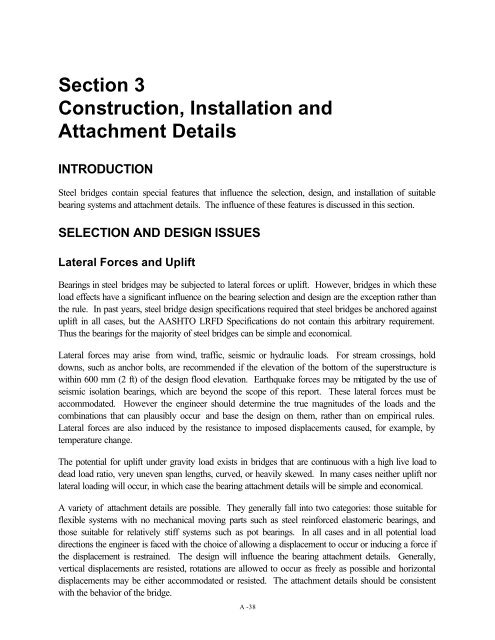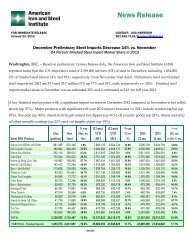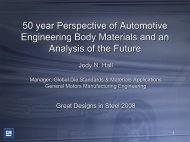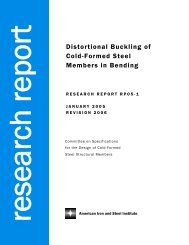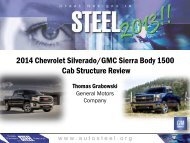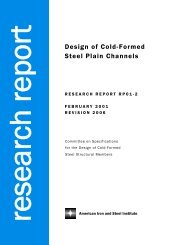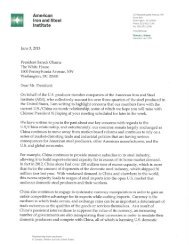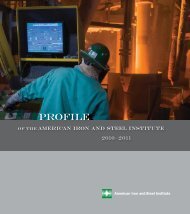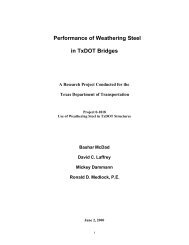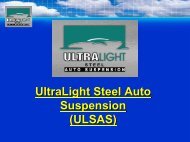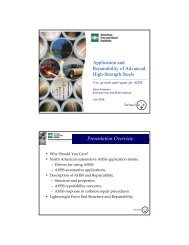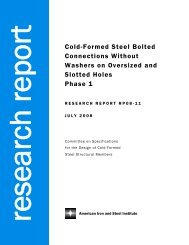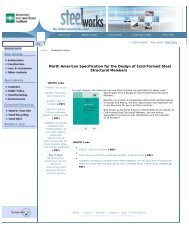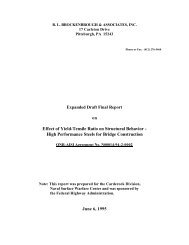Steel Bridge Bearing Selection and Design Guide (Part 3)
Steel Bridge Bearing Selection and Design Guide (Part 3)
Steel Bridge Bearing Selection and Design Guide (Part 3)
Create successful ePaper yourself
Turn your PDF publications into a flip-book with our unique Google optimized e-Paper software.
Section 3<br />
Construction, Installation <strong>and</strong><br />
Attachment Details<br />
INTRODUCTION<br />
<strong>Steel</strong> bridges contain special features that influence the selection, design, <strong>and</strong> installation of suitable<br />
bearing systems <strong>and</strong> attachment details. The influence of these features is discussed in this section.<br />
SELECTION AND DESIGN ISSUES<br />
Lateral Forces <strong>and</strong> Uplift<br />
<strong>Bearing</strong>s in steel bridges may be subjected to lateral forces or uplift. However, bridges in which these<br />
load effects have a significant influence on the bearing selection <strong>and</strong> design are the exception rather than<br />
the rule. In past years, steel bridge design specifications required that steel bridges be anchored against<br />
uplift in all cases, but the AASHTO LRFD Specifications do not contain this arbitrary requirement.<br />
Thus the bearings for the majority of steel bridges can be simple <strong>and</strong> economical.<br />
Lateral forces may arise from wind, traffic, seismic or hydraulic loads. For stream crossings, hold<br />
downs, such as anchor bolts, are recommended if the elevation of the bottom of the superstructure is<br />
within 600 mm (2 ft) of the design flood elevation. Earthquake forces may be mitigated by the use of<br />
seismic isolation bearings, which are beyond the scope of this report. These lateral forces must be<br />
accommodated. However the engineer should determine the true magnitudes of the loads <strong>and</strong> the<br />
combinations that can plausibly occur <strong>and</strong> base the design on them, rather than on empirical rules.<br />
Lateral forces are also induced by the resistance to imposed displacements caused, for example, by<br />
temperature change.<br />
The potential for uplift under gravity load exists in bridges that are continuous with a high live load to<br />
dead load ratio, very uneven span lengths, curved, or heavily skewed. In many cases neither uplift nor<br />
lateral loading will occur, in which case the bearing attachment details will be simple <strong>and</strong> economical.<br />
A variety of attachment details are possible. They generally fall into two categories: those suitable for<br />
flexible systems with no mechanical moving parts such as steel reinforced elastomeric bearings, <strong>and</strong><br />
those suitable for relatively stiff systems such as pot bearings. In all cases <strong>and</strong> in all potential load<br />
directions the engineer is faced with the choice of allowing a displacement to occur or inducing a force if<br />
the displacement is restrained. The design will influence the bearing attachment details. Generally,<br />
vertical displacements are resisted, rotations are allowed to occur as freely as possible <strong>and</strong> horizontal<br />
displacements may be either accommodated or resisted. The attachment details should be consistent<br />
with the behavior of the bridge.<br />
A -38
Small Lateral Force <strong>and</strong> No Uplift<br />
The majority of bearings fall into this category, so it is important. Lateral forces are small in bearings<br />
that are equipped with a PTFE slider, or in a flexible bearing adjacent to some fixed point in the bridge.<br />
Attachment details for flexible (e.g. elastomeric) <strong>and</strong> stiff systems are discussed separately. In most<br />
cases the details are economical because the requirements are modest.<br />
Minimum Attachment Details for Flexible <strong>Bearing</strong>s<br />
An elastomeric bearing pad or steel reinforced elastomeric bearing may simply be placed under the<br />
girder with no positive attachment, as shown in Figure II-3.1. It is held in place by friction <strong>and</strong> its main<br />
function is to accommodate rotations. The detail is the most economical possible.<br />
Figure II-3.1: Attachment of an Elastomeric <strong>Bearing</strong> with<br />
Small Lateral Load <strong>and</strong> No Uplift<br />
The possibility of slip should be checked using the load combination with the maximum possible<br />
concurrent ratio of horizontal load/vertical load. Elastomers typically exhibit less friction against steel<br />
than against concrete, especially if the latter has been intentionally left rough, so the steel-elastomer<br />
interface is the likely location for potential slip. The friction coefficient between elastomer <strong>and</strong> steel<br />
varies with pressure <strong>and</strong> surface condition, but a value of 0.2 is usually attainable <strong>and</strong> is recommended<br />
in the AASHTO LRFD Specifications (10) . This friction value will be high enough to prevent slip,<br />
provided that the maximum horizontal load does not occur in conjunction with an exceptionally light<br />
vertical load. This follows from the fact that the bearing's shear deformation is limited by the AASHTO<br />
LRFD Specifications to 0.5 h rt , <strong>and</strong> small shear deformations imply small lateral loads.<br />
It should be noted that a recent study (7) has shown that some elastomer compounds exhibit very low<br />
friction <strong>and</strong> that bearings made from them have slipped out of place. The effect was found to occur only<br />
with bearings made from certain natural rubber compounds which contain large quantities of antiozonant<br />
waxes. Furthermore, some of the bearings in question were set on very smooth concrete<br />
surfaces.<br />
Minimum Attachment Details for HLMR <strong>Bearing</strong>s<br />
HLMR bearings, such as pot or spherical bearings, theoretically need no attachment for service load<br />
since, under the specified conditions of small lateral load <strong>and</strong> no uplift, friction will be adequate to<br />
A -39
prevent movement. However, they contain mechanical moving parts, <strong>and</strong> the consequences of these<br />
components becoming misaligned by unexpected bearing movements are grave. Furthermore, small<br />
superstructure movements could lead to large forces in stiff bearing systems. Therefore HLMR bearings<br />
are required to be bolted to the support.<br />
Uplift Alone<br />
Potential uplift displacements may either be permitted to occur or they may be restrained, in which case<br />
a force is developed in the restraining system. Mechanical bearings are almost always restrained against<br />
uplift to prevent the bearing damage that might occur if components become misaligned. In elastomeric<br />
systems, uplift displacements may be acceptable provided that expansion joint <strong>and</strong> girder misalignment<br />
cannot occur <strong>and</strong> that the impact loading caused by renewed contact with the piercap is acceptable.<br />
Elastomeric bearings are likely to return to their zero strain position during uplift, <strong>and</strong> therefore the<br />
effective installation temperature of the bearing will be the temperature of the bridge when the<br />
superstructure <strong>and</strong> bearing return to contact. This change in effective installation temperature is not a<br />
major concern with flexible bearings, since elastomers are quite forgiving of overly large deformations<br />
that are infrequently applied. Only in extreme cases, are elastomeric bearings likely to required<br />
repositioning after temporary uplift.<br />
Uplift Attachment Details for Flexible <strong>Bearing</strong>s<br />
Elastomeric bearings may be restrained by a simple bolted detail, as shown in Figure II-3.2. Two bolts<br />
placed at the axis of rotation provide the least restraint to rotation while preventing the uplift. A sole<br />
plate (shown in the Figure) is often used to avoid drilling the girder flange. It also allows some tolerance<br />
in the placement of the girder on the sole plate, if the sole plate can be field welded to the girder. (The<br />
sole plate is wider than the girder flange so this weld can be made downh<strong>and</strong>). The erector may also<br />
prefer to shop weld this connection. Possible methods are discussed under "Erection Issues" at the end<br />
of this section.<br />
A -40
Figure II-3.2: Elastomeric <strong>Bearing</strong> with Uplift Restraint<br />
Uplift Attachment Details for HLMR <strong>Bearing</strong>s<br />
Uplift restraint of HLMR bearings poses difficult problems. The restraining system must be sufficiently<br />
rigid to prevent vertical movement, but it must contain sufficient articulation to allow relative rotation,<br />
<strong>and</strong> possibly relative horizontal movement, of the components. Individual manufacturers have proposed<br />
their own hold-down details. Most add significantly to the price of the bearing.<br />
Lateral Load Alone<br />
Some degree of lateral load on a bearing is common. The engineer must decide how many of the<br />
bearings are to resist such loads. In stiff bearing systems, such as pot or spherical bearings, it is often<br />
best to carry the lateral loads on a small number of bearings. This avoids not only the potential<br />
additional loads from restraint of transverse temperature expansion but also the uneven distribution of<br />
applied lateral load that can occur with stiff bearing systems. If this philosophy causes the lateral load<br />
on a single bearing to be too large, particularly compared with its vertical load, a separate guide system<br />
may be used to resist lateral load, as illustrated in Figure II-3.3. The advantage of this approach is that<br />
it separates the functions of carrying the lateral <strong>and</strong> vertical loads <strong>and</strong> permits a wider variety of choices<br />
for the individual components.<br />
Figure II-3.3: Separate <strong>Guide</strong> System for Resisting Lateral Loads<br />
With flexible bearing systems, the deformation needed to accommodate the transverse temperature<br />
expansion is small compared with the overall bridge movements, so all the bearings can be used for<br />
resisting lateral loads.<br />
A -41
Lateral Load Attachment Details for Flexible <strong>Bearing</strong>s<br />
Applied lateral loads, such as from wind forces, should be distinguished from applied longitudinal<br />
displacements, such as caused by thermal expansion. In the former case the bearing should be stiff<br />
enough to prevent excessive movement, or an independent horizontal force resisting system should be<br />
used. In the case of expansion, the displacement is a given so the bearing should be flexible in order to<br />
limit the forces between the substructure <strong>and</strong> superstructure.<br />
The simplest arrangement for resisting applied loads is to use a relatively low-profile elastomeric bearing<br />
with no external restraint as shown in Figure II-3.1. The thickness <strong>and</strong> plan area are selected to furnish<br />
the required stiffness, but the bearing must still be thick enough to accommodate the required rotation.<br />
The possibility of slipping should also be checked. If the lateral loads are caused by wind or traffic<br />
forces, they are likely to be small compared to the dead weight of the bridge, in which case this detail is<br />
viable.<br />
Figure II-3.4: Bolt Detail for Resisting Lateral Loads<br />
If the lateral force is too large for this simple detail, bolts may be used, as shown in Figure II-3.4. The<br />
bolts are loaded in bending <strong>and</strong> shear, so they should be designed properly. Such a detail works if<br />
motion in both horizontal directions is to be prevented. If the bearing is to be free to move in one<br />
direction <strong>and</strong> fixed in the other, slotted holes may theoretically be used. However in practice they risk<br />
freezing up from accumulation of dirt, corrosion <strong>and</strong> layers of paint. In this case some separate guide<br />
system, such as the one shown in Figure II-3.5, may be used.<br />
A -42
Figure II-3.5: <strong>Guide</strong> Detail for Resisting Lateral Loads<br />
Lateral Load Attachment Details for HLMR <strong>Bearing</strong>s<br />
In stiffer systems such as HLMR bearings, the ability to permit movement or resist load depends on the<br />
bearing type.<br />
Among pot bearings, the simplest type is fixed in all directions <strong>and</strong> permits only rotation. A pot bearing<br />
that is free to slide in all directions can be made by adding a PTFE slider, but resisting load in one<br />
direction while permitting movement in the other requires both a slider <strong>and</strong> a guide system. This is<br />
therefore the most complex <strong>and</strong> expensive bearing system.<br />
The same ranking also holds for spherical bearings. However use of spherical bearings should be<br />
considered carefully because of their geometry. A nominally fixed bearing uses only a spherical sliding<br />
surface, but it is not truly fixed because it rotates about the center of the sphere. This point is usually not<br />
at the location of the neutral axis of the girder, so some longitudinal movement must be allowed to occur<br />
or else a longitudinal force will be introduced. Use of a sliding bearing at the other end of the bridge<br />
allows this movement to occur.<br />
The geometry of the guide system may exert a considerable influence on the forces carried by individual<br />
bearing components. For example, in a pot bearing, two external guides or one central 'internal' guide<br />
may be used, as illustrated in Figure II-3.6. If the guides bear against the piston (Figure II-3.6a) the<br />
lateral forces must then be transmitted from the piston to the pot wall by contact stresses. This<br />
arrangement introduces the possibility of heavy wear on the piston rim <strong>and</strong> so is suitable only if the<br />
horizontal loads are low, say less than about 5% of the vertical load. Larger horizontal loads should be<br />
carried by external guides that bear against the outside of the pot wall (Figure II-3.6b), but then enough<br />
clearance must be left to permit rotation of the bearing. For this arrangement, the outside of the pot wall<br />
must also be straight, rather than circular, in plan so a slider can be mounted there. Binding of the<br />
guides during rotation will be minimized if the center of the guide is at the same elevation as the center of<br />
rotation of the bearing. This may be taken as the top surface of the elastomeric pad in a pot bearing.<br />
A -43
a) Internal guide b) External guide<br />
Figure II-3.6: <strong>Guide</strong>s for HLMR <strong>Bearing</strong><br />
The guides should be designed according to principles of structural mechanics. A horizontal force on a<br />
guide typically induces both shear <strong>and</strong> bending (or overturning) moments. Since guidebars are usually<br />
bolted to the top plate, the connection must be designed for the moment as well as the shear. If the<br />
bolts are fitted into drilled <strong>and</strong> tapped holes in the top plate, the plate thickness must be adequate to<br />
develop the full strength of the bolt within the thread length available.<br />
Clearances <strong>and</strong> tolerances are important in the design of guides. Clearance refers to the distance<br />
intentionally placed between two components to permit relative movement. Tolerances are the<br />
unintentional but inevitable variations from nominal values in component dimensions <strong>and</strong> locations. They<br />
arise from both fabrication <strong>and</strong> erection. The net clearance is therefore the nominal clearance plus or<br />
minus the tolerances on the adjacent parts.<br />
A net clearance that is too small may restrict movement, while one that is too large may cause any<br />
lateral loads to be carried by a single bearing, because the guides of the others are not in contact. All<br />
guides at a bent must be installed parallel to each other within a small enough angular tolerance to<br />
prevent binding of the system. Furthermore, the direction selected for free motion at each bent should<br />
be consistent with the that of the movements of the total bridge system, especially in curved or skewed<br />
bridges. The use of unguided bearings, possibly in combination with an independent guide system as<br />
illustrated in Figure II-3.3, should be considered, since this is frequently the most reliable method of<br />
developing large restraint forces or directional guidance for the bearings.<br />
It is clear that guides <strong>and</strong> restraints should be used only if a clearly identified need for them exists. They<br />
have the potential for inducing unexpected <strong>and</strong> unwanted forces into a structure <strong>and</strong> the certainty of<br />
adding cost to the bridge.<br />
Combined Uplift <strong>and</strong> Lateral Load<br />
<strong>Design</strong>ing for combined uplift <strong>and</strong> lateral load is difficult. In pot <strong>and</strong> spherical bearings, providing<br />
restraint against uplift at the same time as allowing free rotation poses problems, <strong>and</strong> designs for these<br />
A -44
earing types therefore tend to be expensive. If the rotation occurs about only one axis <strong>and</strong> the uplift<br />
forces are large, a traditional pin bearing might prove cost-effective. However, many bridges have<br />
some degree of skew, which induces rotation about more than one axis <strong>and</strong> renders this bearing type<br />
unsuitable. Furthermore, such bearings have a high profile <strong>and</strong> are more susceptible than are lowerprofile<br />
bearings to overturning under seismic loads. Elastomeric bearings provide feasible <strong>and</strong><br />
economical solutions under many conditions.<br />
The detail shown in Figure II-3.4 for resisting lateral load will also resist uplift forces. It is simple to<br />
fabricate <strong>and</strong> install. The bolts should be installed at the axis of rotation so that they do not develop<br />
tension when the bearing rocks.<br />
DESIGN FOR REPLACEMENT<br />
<strong>Bearing</strong>s are subjected to severe service conditions, which may lead to service lives that are shorter than<br />
for other bridge components. This is particularly true for systems such as mechanical bearings that<br />
require maintenance. Therefore the need for replacement of all or part of the bearing system must be<br />
considered in the design. It should be emphasized that designing for potential replacement should not,<br />
<strong>and</strong> normally does not, require the addition of expensive details.<br />
The most important aspect of design for replacement is the provision of jacking locations at every<br />
girder. These points must be indicated on the plans. Modern flat jacks make this lifting quite easy<br />
because they have a low profile, do not require a large vertical movement, <strong>and</strong> can lift heavy loads. A<br />
typical flat jack <strong>and</strong> lift detail is shown in Figure II-3.7 There must be space on the piercap <strong>and</strong> a<br />
bearing point on the superstructure to jack up the girder. An alternative to the detail shown in Figure II-<br />
3.7 is to use hydraulic jacks under a temporary spreader beam that lifts adjacent girder top flanges<br />
simultaneously. If only some of the girders are to be lifted at any one time, the jacking force on each<br />
girder may be larger than the nominal load on an individual bearing because the lifting process may<br />
attract some load from the adjacent bearings. This process will also induce stress in some of the cross<br />
members or diaphragms, so using linked jacks to lift all the girders together should be considered.<br />
A -45
Figure II-3.7: Typical Jacking Point <strong>and</strong> Lift Details<br />
A second issue which affects the cost <strong>and</strong> ease of replacement is the attachment of the bearing <strong>and</strong> the<br />
space available for access. If the bearing is unattached, it can easily be pulled from its position when the<br />
load is removed. Any anchor bolts should be placed so that they do not impede the removal of the<br />
bearing. Welds can be cut but doing so requires oxyacetylene equipment that may be cumbersome in<br />
the space available. Grinding may also be needed in order to produce a flat enough surface for installing<br />
the new bearing. Careful monitoring of the girder centerlines is necessary regardless of the method of<br />
bearing removal <strong>and</strong> attachment. In the case of pot bearings, only some of the components, such as the<br />
seals <strong>and</strong> pad, may need replacing. Installing the new components may then be possible without cutting<br />
any welds or removing the bearing, provided the required lift height can be achieved.<br />
A -46
a) Recess in masonry plate<br />
b) Keeper plates bolted or welded to masonry plate.<br />
c) Pot bolted directly to masonry plate<br />
Figure II-3.8: Attachment Details to Facilitate Replacement<br />
Last, the bearing <strong>and</strong> its attachments should also be designed so that the required lift height is minimized.<br />
For this reason the use of a masonry plate under a pot or spherical bearing is desirable, even if it is not<br />
needed for load spreading. A bearing that is connected directly to the piercap by anchor bolts without a<br />
masonry plate must be lifted over the bolts after the nuts have been removed. This arrangement<br />
significantly increases the required lift height <strong>and</strong> complicates the replacement. Three possible details<br />
A -47
that minimize the lift height by using masonry plates are illustrated in Figure II-3.8. A shallow recess<br />
may retain the bearing (Figure II-3.8a), a flat masonry plate may be used with bolted or welded keeper<br />
plates (Figure II-3.8b), or the bottom plate of the bearing may be bolted directly into holes that are<br />
drilled <strong>and</strong> tapped into the masonry plate (Figure II-3.8c). The height needed for removing <strong>and</strong><br />
installing bolts should be accounted for.<br />
BEARING ROTATIONS DURING CONSTRUCTION<br />
<strong>Steel</strong> girders often have substantial camber before installation <strong>and</strong> this results in a large initial rotation on<br />
the bridge bearing while the compressive load on it is very small. The steel girder is quite flexible until<br />
the concrete deck develops composite action, <strong>and</strong> significant girder deflection <strong>and</strong> bearing rotation<br />
occur during placement of the deck. The bearings must clearly be designed so that they can tolerate<br />
these rotations, but the forces that are applied at the same time are usually much smaller than the<br />
maximum loads.<br />
In elastomeric bearings, the load that can be carried is related to the rotation (10) . However the<br />
combination of erection forces <strong>and</strong> rotations is unlikely to cause problems because it is applied only<br />
once during the life of the bridge <strong>and</strong> damage to elastomeric bearings generally arises from the<br />
accumulation of many cycles of stress. The elastomeric bearing design provisions in the AASHTO<br />
LRFD Specifications (10) were developed for repeated cycles of service load, so they are not applicable<br />
to a single application of a construction load combination.<br />
In bearings such as pots or sphericals, the rotation capacity is limited by metal-to-metal contact <strong>and</strong> is<br />
not related to the accompanying load. These bearings must therefore be designed to accommodate the<br />
full rotation.<br />
CONSTRUCTION ISSUES<br />
Erection Methods<br />
<strong>Steel</strong> bridge superstructures are fabricated in a shop <strong>and</strong> so they do not offer opportunities for large<br />
adjustments to the dimensions on site. Therefore methods of erecting steel bridges have evolved to<br />
allow for such adjustments. The primary problem is that the substructure contractor may not have<br />
placed the anchor bolts in the piers (or even the piers themselves) with sufficient accuracy to permit easy<br />
installation of the bearing, or masonry plate if one exists. Longitudinal location errors are more common<br />
than transverse ones. The problems are more severe with stiff systems such as pot, spherical or<br />
mechanical bearings than with elastomeric bearings, because they contain more anchor bolts <strong>and</strong><br />
because the potential for damage by misalignment is greater. Where a bearing has no anchor bolts, the<br />
problems are vastly simplified. The real need for anchorage should therefore be carefully assessed.<br />
The most satisfactory approach is to exert strict control over the work of the subcontractor so that the<br />
anchor bolts are correctly located, but this is not always easy or even possible. If this is not feasible,<br />
there are several possible adjustment locations for achieving the necessary longitudinal tolerance. The<br />
A -48
piers themselves may be jacked, or adjustments may be made at the interfaces between pier <strong>and</strong><br />
masonry plate, bearing top plate <strong>and</strong> sole plate, or sole plate <strong>and</strong> girder. Each adjustment location has<br />
advantages <strong>and</strong> drawbacks.<br />
Jacking the piers may damage the substructure. The possibility of moving the masonry plate relative to<br />
the pier depends on the anchor bolt installation technique. Many erectors like to run an accurate survey<br />
of the pier locations, then drill or core the piers so that the bolts can be correctly located for the girder<br />
<strong>and</strong> bearing. This approach solves the adjustment problem, but there is a risk of drilling through critical<br />
reinforcement, <strong>and</strong> in extreme cases, the bolts may be far from their intended location <strong>and</strong> the<br />
reinforcement in the concrete substructure may not be suited for the loading that results. This method<br />
may also provide insufficient tension capacity in the bolts in case of uplift if the sides of the holes are<br />
smooth. One alternative is to pre-form in the concrete oversize holes that are large enough to provide<br />
the necessary tolerance <strong>and</strong>, in cases where uplift may occur, to use a steel tube with a plate washer at<br />
the bottom, such as shown in Figure II-3.9. The holes are grouted after the bearing or masonry plate<br />
has been set. Another possibility is to use oversize holes in the bearing plate or masonry plate <strong>and</strong> to<br />
use plate washers over them. This arrangement requires adequate height <strong>and</strong> may not be feasible with<br />
low-profile bearings.<br />
Adjustments may be made between the bearing top plate <strong>and</strong> the sole plate, if both exist. If the bearing<br />
has a top plate, it may be bolted to the sole plate using oversized or slotted holes. Again, vertical<br />
clearances for bolting should be verified. The adjustment that can be made by this method is somewhat<br />
limited unless the bearing top plate <strong>and</strong> the sole plate are large.<br />
Figure II-3.9: <strong>Steel</strong> Tube Detail for Anchor Bolts<br />
The sole plate may also be adjusted, at least longitudinally, relative to the girder flange provided that the<br />
two are then site welded. This is feasible, but requires site welding under conditions that might be<br />
difficult. If the bearing is elastomeric, it also risks heat damage from the welding. Temperature sensitive<br />
crayons or other means must be used to ensure that the elastomer is not overheated.<br />
A -49
In all cases, dimensional control must be properly maintained. This requires at least that the centerline of<br />
the bearing be clearly marked so that discrepancies from the nominal bearing location can be properly<br />
identified <strong>and</strong> monitored.<br />
Stability of <strong>Bearing</strong> <strong>and</strong> Girder During Erection<br />
<strong>Steel</strong> bridges usually contain diaphragms or transverse bracing for lateral support of the girders. The<br />
structure is very stable in its complete configuration, but the girders may be relatively unstable during<br />
construction. This is particularly true for curved girders but is also true for individual girders on straight<br />
bridges. Multiple straight girders installed with diaphragms already in place should significantly reduce<br />
the potential for lateral instability for all bearing types, but they require heavier cranes.<br />
The rotational flexibility of the bearings about the girder's longitudinal axis may aggravate this temporary<br />
instability, particularly for curved girders or single girders. In service, the girders are stabilized against<br />
such rotations by bracing, but it may not be installed until several girders are in place. It is more<br />
economical to provide stability by temporary locking the bearing against deformation or by temporary<br />
bracing the girder, rather than designing a permanent restraint of some sort. Contractors are capable of<br />
providing this bracing, but the need for temporary bracing should be shown on the plans.<br />
A -50
REFERENCES<br />
1. Priestly, M.J.N, "<strong>Design</strong> Thermal Gradients for Concrete <strong>Bridge</strong>s", New Zeal<strong>and</strong> Engineering, Vol<br />
31, <strong>Part</strong> 9, September 1976, pp 213-219.<br />
2. Emerson, M., “<strong>Bridge</strong> Temperature Estimated from the Shade Temperature,” TRRL Report 696,<br />
Department of Transport, Crowthorne, Engl<strong>and</strong>, 1976.<br />
3. Moorty, S., <strong>and</strong> Roeder, C.W., "Temperature Dependent <strong>Bridge</strong> Movements", ASCE, Journal of<br />
Structural Division, Vol. 105, No. 4, New York, April 1992.<br />
4. Muller-Rochholz, J.F.W., <strong>and</strong> Fiebrich, M., "Measurement of Horizontal <strong>Bridge</strong> Movements due to<br />
Temperature, Wind <strong>and</strong> Traffic Loadings", ACI Special Publication SP-94, Joint Sealing <strong>and</strong><br />
<strong>Bearing</strong> Systems for Concrete Structures, Vol 1., American Concrete Institute, Detroit, MI<br />
1986.<br />
5. Roeder, C.W., Stanton, J.F. <strong>and</strong> Feller,T., "Low Temperature Behavior <strong>and</strong> Acceptance Criteria<br />
for Elastomeric <strong>Bridge</strong> <strong>Bearing</strong>s," NCHRP Report 325, National Research Council, Washington,<br />
DC, 1990.<br />
6. Roeder, C.W., Stanton, J.F. <strong>and</strong> Feller, T., "Low Temperature Performance of Elastomers,"<br />
ASCE, Cold Regions Journal, Vol. 4, No. 3, 1990.<br />
7. Muscarella, J. V., "An Experimental Study of Elastomeric <strong>Bridge</strong> <strong>Bearing</strong>s with <strong>Design</strong><br />
Recommendations", A thesis submitted in partial fulfillment of the requirements of the degree<br />
of the doctor of philosophy, University of Texas, Austin, Texas, August 1995.<br />
8. Stanton, J.F. <strong>and</strong> Roeder, C.W., "Elastomeric <strong>Bearing</strong>s - <strong>Design</strong>, Construction <strong>and</strong> Materials,"<br />
NCHRP Report 248, National Research Council, Washington, DC, 1982.<br />
9. Roeder, C.W. <strong>and</strong> Stanton, J.F., "Elastomeric <strong>Bearing</strong>s: A State of the Art," ASCE, Journal of<br />
Structural Division, Vol. 109, No. 12, December 1983.<br />
10. AASHTO LRFD <strong>Bridge</strong> <strong>Design</strong> Specifications, SI Units, First Edition, AASHTO, Washington,<br />
D.C., 1994.<br />
11. Roeder, C.W., Stanton, J.F. <strong>and</strong> Taylor, A., "Elastomeric <strong>Bearing</strong>s - <strong>Design</strong> Construction <strong>and</strong><br />
Materials," NCHRP Report 298, National Research Council, Washington, DC, 1987.<br />
12. Roeder, C.W. <strong>and</strong> Stanton, J.F., "State of the Art Review of Pot <strong>Bearing</strong>s <strong>and</strong> PTFE Sliding<br />
Surfaces," Report to NCHRP, 1988.<br />
13. McEwen, E.E., <strong>and</strong> Spencer, G.D., "Finite Element Analysis <strong>and</strong> Experimental Results Concerning<br />
Distribution of Stress Under Pot <strong>Bearing</strong>s", ACI Special Publication SP-70, Joint Sealing <strong>and</strong><br />
A -51
<strong>Bearing</strong> Systems for Concrete Structures, Vol 2, American Concrete Institute, Detroit, MI,<br />
1981.<br />
14. Roeder, C.W., Stanton, J.F., <strong>and</strong> Campbell, T.I., "High Load Multi-Rotational <strong>Bridge</strong> <strong>Bearing</strong>s",<br />
Final Report, NCHRP 10-20A, TRB, National Research Council, National Academy of Science,<br />
Washington, D.C., May 1993.<br />
15. Roeder, C.W., Stanton, J. F., <strong>and</strong> Campbell, T.I., "Rotation of High Load Multirotational <strong>Bridge</strong><br />
<strong>Bearing</strong>s", ASCE, Journal of Structural Engineering, Vol. 121, No. 4, New York, April 1995.<br />
16. St<strong>and</strong>ard Specifications for Highway <strong>Bridge</strong>s, Fifteenth Edition, AASHTO, Washington, D.C.,<br />
1993.<br />
17. Campbell, T.I., Pucchio, J.B., Roeder, C.W. <strong>and</strong> Stanton, J.F., "Frictional Characteristics of PTFE<br />
Slide Surfaces Used in <strong>Bridge</strong> <strong>Bearing</strong>s," Proceedings, ACI, 3rd World Congress on Joints <strong>and</strong><br />
Sealants, Toronto, Canada, October 1991.<br />
18. Campbell, T.I., <strong>and</strong> Kong, W.L., "Laboratory Study of Friction in TFE Sliding Surfaces for <strong>Bridge</strong><br />
<strong>Bearing</strong>s", Report MAT-89-04, Ministry of Transportation, Downsview, Ontario, Canada, May<br />
1988.<br />
19. Campbell, T.I., <strong>and</strong> Fatemi, M.J., "Further Laboratory Study of Friction in TFE Sliding Surfaces<br />
for <strong>Bridge</strong> <strong>Bearing</strong>s", Report MAT-89-06, Ministry of Transportation, Downsview, Ontario,<br />
Canada, October 1989.<br />
A -52
Appendix A:<br />
Test Requirements<br />
GENERAL<br />
A number of tests are required to ensure satisfactory performance of bridge bearings. Most of these<br />
tests are described in detail in the AASHTO LRFD Specifications <strong>and</strong> other documents. These tests<br />
are normally used to achieve one of three objectives. First, material tests are used to assure that the<br />
properties are consistent with those used in the design. Second, quality control tests on the completed<br />
bearing are conducted to verify that the bearing was built to satisfactory quality st<strong>and</strong>ards <strong>and</strong><br />
tolerances. Finally, tests are sometimes conducted to simulate service conditions in order to evaluate<br />
the service life of the bearing. These three major objectives are discussed separately, although there is<br />
clearly some overlap.<br />
TESTS TO VERIFY DESIGN REQUIREMENTS<br />
Most material tests are outlined in the appropriate ASTM <strong>and</strong> AASHTO Material St<strong>and</strong>ards.<br />
However, PTFE <strong>and</strong> elastomers require special testing because their behavior can not be predicted by<br />
indirect measures or physical examination.<br />
Friction Testing of PTFE<br />
The coefficient of friction in PTFE depends on many variables such as contact pressure, sliding speed<br />
<strong>and</strong> temperature. Friction can have a large impact on the forces transmitted from the superstructure to<br />
the substructure, <strong>and</strong> these forces influence the economy of the entire bridge design.<br />
The material for the test specimens must be identical to that in the manufactured bearing <strong>and</strong> the test<br />
specimens may be comprised of material taken from r<strong>and</strong>omly selected bearings from the lot supplied<br />
by the manufacturer; complete bearings may also be used. The test pieces are loaded with a<br />
compressive stress corresponding to their maximum stress due to service dead plus live load, which is<br />
then held constant for one hour prior to, <strong>and</strong> throughout the duration of, the sliding test. At least 100<br />
cycles of sliding, each consisting of at least ±25 mm (1 in.) of movement, are then applied at a<br />
temperature of 20 o C (68 o F). Additional low temperature tests may be required if the bridge site is<br />
located in a cold region. The tests are normally performed at a uniform sliding speed of 63 mm/min (2.5<br />
in./min). The breakaway friction coefficient is computed for each direction of each cycle, <strong>and</strong> its mean<br />
<strong>and</strong> st<strong>and</strong>ard deviation are computed for the sixth through twelfth cycles.<br />
The initial breakaway coefficient of friction for the first cycle can not exceed twice the design coefficient<br />
of friction, <strong>and</strong> the maximum value for all subsequent cycles can not exceed the design coefficient of<br />
friction. A multiplier of 2 is applicable for the first cycle because that criterion would otherwise<br />
A - 1
dominate. It is justified by the low probability of finding the full gravity load on the bearing at the time of<br />
initial slip. The very first movement almost always occurs during transportation or bridge erection.<br />
Further, the normal margin of safety used in bridge design accommodates some one time overload.<br />
These tests assure that the bearing does not deliver a larger force to the superstructure or substructure<br />
than considered by the design engineer.<br />
Shear Stiffness of Elastomeric <strong>Bearing</strong>s<br />
The shear modulus of the elastomer is the primary design requirement for steel reinforced elastomeric<br />
bearings or elastomeric bearing pads. The shear modulus test can be made from a specimen cut from a<br />
r<strong>and</strong>omly selected bearing (an extra bearing must be manufactured to provide this specimen) or a<br />
comparable non-destructive stiffness test may be conducted on a pair of finished bearings. The test<br />
apparatus <strong>and</strong> procedure for small specimens are described in Annex A of ASTM D4014, St<strong>and</strong>ard<br />
Specification for Plain <strong>and</strong> <strong>Steel</strong>-Laminated Elastomeric <strong>Bearing</strong>s for <strong>Bridge</strong>s. The shear modulus<br />
must fall within ±15 percent of the specified value, or within the range for its hardness given in the<br />
AASHTO LRFD Specifications if no shear modulus is specified.<br />
If the test is conducted on finished bearings, the material shear modulus must be computed from the<br />
measured shear stiffness of the bearings taking due account of the influence on shear stiffness of bearing<br />
geometry <strong>and</strong> compressive load. There are considerable difficulties associated with predicting bearing<br />
shear stiffness from material modulus, or vice versa, because of the complex interaction of compressive<br />
<strong>and</strong> shear loads in an elastomeric bearing. For this reason, it is important not to specify both material<br />
modulus <strong>and</strong> bearing stiffness.<br />
Elastomers stiffen at low temperatures. The extent depends upon the elastomer compound, the<br />
temperature <strong>and</strong> the duration of exposure. If an inappropriate elastomer compound is used the shear<br />
forces may be more than 100 times as large as those obtained at room temperature. They can cause<br />
severe damage to a bridge. The materials for bearings to be used in extremely cold climates must be<br />
subjected to the low temperature shear test. The three primary tests to be used are the Low<br />
Temperature Brittleness test (ASTM D746), the Instantaneous Low Temperature Stiffness test (ASTM<br />
D1043) <strong>and</strong> the Low Temperature Crystallization test (ASTM D4014). The test temperature depends<br />
upon the elastomer grade, <strong>and</strong> the required grade depends upon climatic conditions at the bridge site.<br />
For the low temperature crystallization <strong>and</strong> low temperature stiffness tests, the stiffness at the test<br />
temperature cannot exceed 4 times the stiffness noted at room temperature.<br />
Low temperature testing is important only for bearings to be used in colder climates in the United States,<br />
so it is required only for elastomeric bearings made from low temperature grades 4 <strong>and</strong> 5. The low<br />
temperature tests are more expensive than the basic physical property tests, so the AASHTO LRFD<br />
Specifications require the manufacturer to provide certified test results conducted on the same<br />
compound within one year of the date of manufacture of the bearings, unless specific testing is required<br />
by the engineer.<br />
A -2
TESTS TO ASSURE QUALITY OF THE MANUFACTURED<br />
PRODUCT<br />
These tests are intended to assure that the bearings are manufactured to appropriate tolerances <strong>and</strong><br />
clearances. Engineers are familiar with many tests of this type <strong>and</strong> little additional discussion is required.<br />
However, a few tests such as proof load tests on elastomeric bearings require some illustration.<br />
Short Duration Proof Load Test of Elastomeric <strong>Bearing</strong>s<br />
Elastomeric bearings are different than most structural components. Satisfactory bearing behavior<br />
requires a well manufactured product. Appropriate curing is needed to obtain the correct elastomer<br />
material properties <strong>and</strong> scrupulous cleanliness is needed to achieve satisfactory bond.<br />
Division II of the AASHTO St<strong>and</strong>ard Specifications for Highway <strong>Bridge</strong>s requires that every<br />
elastomeric bearing which is designed for high stress applications be subjected to a short duration load<br />
test. The bearing is loaded in compression to 150 percent of its rated service load. If the bearing is<br />
subjected in service to a rotation <strong>and</strong> compression, a tapered plate should be introduced in the load<br />
path so that the bearing sustains the load at the maximum simultaneous design rotation. The load shall<br />
be held for 5 minutes, removed, then reapplied for a second period of 5 minutes. The bearing should be<br />
examined visually while under the second loading. Any defect results in rejection of the bearing. A<br />
good bearing manufacturer can do this test very quickly <strong>and</strong> economically, since the press needed to<br />
manufacture the bearing can also be used to test it.<br />
The test provides valuable information since any instances of poor dimensional tolerances <strong>and</strong> poor<br />
bond between the steel <strong>and</strong> elastomer will usually be visible. Further, it provides the owner a quick<br />
check of the manufacturer, since the test can be repeated on r<strong>and</strong>omly selected bearings. No deflection<br />
data is required.<br />
Long Duration Load Test for Elastomeric <strong>Bearing</strong>s<br />
Division II of the AASHTO St<strong>and</strong>ard Specifications for Highway <strong>Bridge</strong>s requires a long duration<br />
proof load test on a small number of bearings, r<strong>and</strong>omly selected from any lot, which are designed for<br />
high stress applications. The test is conducted in the same way as the short-duration proof load test<br />
except that the second load is maintained for 15 hours. If the load drops below 90 percent of its target<br />
value during this time, the load must be increased to the target value <strong>and</strong> the test duration must be<br />
increased by the period of time for which the load was below the required value. Any splits, cracking,<br />
delamination, or improper placement of steel plates results in rejection of the lot of bearings. The long<br />
duration load test is important because it will reveal poor bond which is missed in the short duration load<br />
test.<br />
A -3
Tests to Verify Manufacturing of Special Components<br />
Tests may be required to verify that some special components have been manufactured properly.<br />
Examples are guides <strong>and</strong> their attachments for sliding pot bearings, <strong>and</strong> durability tests on elements such<br />
as seals in pot bearings. The intent is to ensure that the finished bearing will behave as specified by the<br />
designer. However, these tests differ from materials tests in that the item being verified is part of the<br />
manufacturing process rather than a material that is incorporated in it.<br />
Criteria for such tests should be specified by the engineer, should be related as closely as possible to the<br />
service function of the component, <strong>and</strong> should be agreed upon with the manufacturer before production<br />
starts.<br />
PROTOTYPE TESTS<br />
Most bearing problems in the field arise from the accumulation of many cycles of load <strong>and</strong> movement.<br />
Tests that simulate field conditions are useful but are too expensive <strong>and</strong> time-consuming to be used as<br />
quality control tests. However, they provide an excellent basis for evaluating the suitability of a new<br />
bearing system or creating a performance specification.<br />
To accelerate the testing, use a smaller number of cycles than would occur during the design life of the<br />
bearing along with larger loads <strong>and</strong> displacements. It is seldom possible to provide an exact<br />
equivalence between such a test <strong>and</strong> real field conditions. However, accelerated testing is valuable for<br />
ranking the behavior of different systems <strong>and</strong> for illuminating defects. Tests of this type can be used to<br />
explore the effects of factors such as debris accumulation <strong>and</strong> contamination. Care must be taken to<br />
avoid introducing new conditions in the test, such as elevated temperatures caused by high speed<br />
testing.<br />
One such accelerated test program has been proposed for rotational elements. It was used on an<br />
extensive series of tests on pot <strong>and</strong> spherical bearings. This test consisted of 5000 cycles of ±0.02<br />
radians rotation at a rate of approximately 1.5 cycles/min. The rotation limit was chosen because many<br />
bearing systems are designed for a rotation capacity of ±0.02 radians, so it represented a way of<br />
applying the most severe movements possible without exceeding the design limits. The best available<br />
evidence suggests that cyclic rotations in the order of ±0.005 radians are more common for traffic<br />
loading or temperature effects, but millions of cycles of rotation due to traffic loading <strong>and</strong> many<br />
thous<strong>and</strong>s of temperature cycles are possible. As a result, this test procedure was applied for 5000 or<br />
10 000 cycles to simulate a substantial service life.<br />
A -4
Appendix B<br />
<strong>Steel</strong> Reinforced Elastomeric <strong>Bearing</strong><br />
<strong>Design</strong> Spreadsheet <strong>and</strong> Examples<br />
INTRODUCTION<br />
This Appendix contains instructions <strong>and</strong> examples that illustrate the use of the included spreadsheet titled<br />
AISIBRGS.XLS for designing rectangular steel-reinforced elastomeric bearings. The objective is to<br />
achieve a design that satisfies the constraints of the AASHTO LRFD Specifications with the least effort<br />
on the part of the engineer. The spreadsheet offers the advantages of allowing alternative designs to be<br />
assessed quickly to avoid tedious <strong>and</strong> potentially error-prone numerical calculations.<br />
USE OF SPREADSHEET<br />
This Microsoft Excel spreadsheet is largely self explanatory. Data must be entered in the outlined cells.<br />
The equations used by the spreadsheet can be seen in Figures B-1a <strong>and</strong> B-1b. Alphabetic entries (e.g.<br />
y or n) are not case-sensitive. The information given in this appendix is general in nature. Whenever<br />
possible the designer should consult with a bearing manufacturer who is likely to supply the bearings<br />
being designed to gather information on material properties <strong>and</strong> fabrication practices. This information<br />
will ensure the economy of the bearing design.<br />
Input Data<br />
In the section of the spreadsheet marked “INPUT DATA”, the material properties <strong>and</strong> loads are<br />
defined by the user. Variables are defined in Table B-A.<br />
Care must be taken with the co-ordinates. Rotation is assumed to take place about only one axis,<br />
which is defined as the y axis. In most bridges this will be the transverse axis. Buckling must eventually<br />
be checked for both directions, so the fixity against translation must be entered for both. In a bridge<br />
that is fixed against longitudinal <strong>and</strong> transverse movement at one end but free to exp<strong>and</strong> at the other, the<br />
fixed end will have translation fixed for both the x <strong>and</strong> y directions. The expansion end will be fixed in<br />
the x direction <strong>and</strong> free to translate in the y direction (the x-fixity arises because the bridge is fixed<br />
against longitudinal translation at the other end <strong>and</strong> it does not stretch).<br />
B - 1
Variable Unit Description<br />
Date<br />
Cell is formatted to accept six digit numerical entry corresponding to<br />
##/##/## for date.<br />
Job Title<br />
Cell is unformatted. Entry of any data is permissible.<br />
G min<br />
G max<br />
MPa Minimum <strong>and</strong> maximum elastomer shear modulus. If the elastomer selected<br />
is specified by hardness, enter minimum <strong>and</strong> maximum shear modulus values<br />
into the appropriate cells. If the chosen elastomer is defined by shear<br />
modulus, enter that single value into both the minimum <strong>and</strong> maximum fields.<br />
Shear modulus values range from 0.55 to 1.25 MPa. A typical elastomer<br />
with a 55 Shore A Durometer hardness would have about a 0.7 to 0.9 MPa<br />
shear modulus range.<br />
k bar<br />
Elastomer material property. This material property is used to calculate the<br />
effective modulus of the elastomer in compression. It is defined in NCHRP<br />
report 248 <strong>and</strong> varies from about 0.9 to 0.5 as the Shore A Durometer<br />
hardness varies from about 40 to 70. A value of 0.6 is suitable for most<br />
bridge bearing elastomers.<br />
F y<br />
MPa Yield strength of steel reinforcement. In general, bearing manufacturers do<br />
not use steel reinforcement grades other than AASHTO M270 Grade 250,<br />
F y = 250 MPa.<br />
(DF) TH MPa Fatigue limit stress of steel reinforcement. As defined in Table 6.6.1.2.5-3<br />
of the AASHTO LRFD Specifications, (DF) TH for steel reinforcement<br />
layers without holes or discontinuities is 165 MPa.<br />
h cover<br />
mm Thickness of elastomeric cover layer. This dimension is used to calculate<br />
the total height of the bearing. A typical cover of 3 mm is usually applied.<br />
P DL kN Service dead load.<br />
P LL kN Service live load.<br />
rotn. rad Rotation of girder at bearing concurrent with specified loads.<br />
D s<br />
mm Shear displacement of bearing concurrent with specified loads.<br />
Trans. fixed x Translation fixed in the x direction. The x direction is assumed along the<br />
longitudinal axis of the bridge. Enter y if the bearing is fixed against<br />
translation in this direction or n if the bearing is free to sway in this direction.<br />
Trans. fixed y Translation fixed in the y direction. The y direction is assumed along the<br />
transverse axis of the bridge. Enter y if the bearing is fixed against<br />
translation in this direction or n if the bearing is free to sway in this direction.<br />
<strong>Bearing</strong> <strong>Design</strong><br />
Table B-A: Descriptions of Variables for “INPUT DATA”<br />
In the section of the spreadsheet marked “BEARING DESIGN” the user defines the geometric<br />
properties of the bearing through an interactive process. Variables are defined in Table B-B. The most<br />
efficient bearing design is likely to be achieved by balancing N lay (comp) <strong>and</strong> N lay (uplift). That is, using<br />
B-2
a bearing geometry that requires about the same number of internal elastomer layers to satisfy both the<br />
combined compression <strong>and</strong> rotation limits of Eq. 2-7 <strong>and</strong> the uplift requirements of either Eq. 2-10a or<br />
Eq. 2-10b.<br />
Variable Unit Description<br />
L<br />
mm <strong>Bearing</strong> dimension perpendicular to rotation axis. This is in the assumed x<br />
direction or along the longitudinal axis of the bridge.<br />
W<br />
mm <strong>Bearing</strong> dimension parallel to rotation axis. The rotation axis is assumed to<br />
be in the y direction or along the transverse axis of the bridge. In general,<br />
this dimension should be as large as practical to permit rotation about the<br />
transverse axis <strong>and</strong> to stabilize the girder during erection. However, the<br />
bearing should be slightly narrower than the flange unless a stiff sole plate is<br />
used to insure uniform distribution of compressive stress <strong>and</strong> strain over the<br />
bearing area.<br />
h ri<br />
mm Thickness of a single internal elastomer layer. Although a minimum<br />
elastomer thickness of 3 mm is achievable by most manufacturers, typical<br />
bearings have a layer thickness in the range of 6 to 15 mm. In general, an<br />
initial trial of a 10 mm layer thickness is used.<br />
N layers<br />
Number of internal elastomer layers. See discussion below.<br />
h s mm Thickness of steel reinforcement layer. Although a minimum steel<br />
reinforcement thickness of 2 mm is achievable by most bearing<br />
manufacturers, a 3 mm thickness or greater is preferred due to tolerance<br />
control limitations during the fabrication process.<br />
Table B-B: Descriptions of Variables for “DESIGN BEARING”<br />
Limiting values for each variable in question are reported on the left side of this spreadsheet section. In<br />
some cases, more than one behavioral characteristic influences the variable, so more than one limit<br />
exists. For example, the number of elastomer layers is influenced by uplift, combined compression<br />
shear <strong>and</strong> rotation, <strong>and</strong> stability in both the x <strong>and</strong> y directions. Some limits are upper bounds <strong>and</strong> some<br />
are lower bounds.<br />
The entry boxes on the right side of this spreadsheet section are to be used by the designer to select a<br />
bearing parameter based on the reported limits. As each value is entered, the reported limits change<br />
appropriately. A check (OK or NG) appears on the extreme right side. If some of the multiple limits<br />
are mutually exclusive, the design is impossible <strong>and</strong> the user must select a different value for one of the<br />
earlier variables. For example, the number of layers may have to be less than 10 <strong>and</strong> greater than 20, in<br />
which case a different layer thickness or plan dimension should be tried.<br />
The four variables related to the elastomer layers are interdependent, <strong>and</strong> should be selected first. The<br />
steel thickness is independent of other variables <strong>and</strong> may be selected last.<br />
B-3
Summary<br />
The section of the spreadsheet marked “SUMMARY” reports the final bearing properties. The<br />
maximum shear force occurs at the design displacement. If the maximum shear force is unacceptably<br />
large, it can be reduced by making the bearing thicker or by adding a slider.<br />
EXAMPLE 1: BEARING FOR TYPICAL LONG-SPAN BRIDGE<br />
Same as example in Section 2.<br />
Dead Load<br />
Live Load<br />
Longitudinal Translation<br />
Rotation<br />
Buckling<br />
Elastomer<br />
<strong>Steel</strong><br />
2400 kN (540 kips)<br />
1200 kN (270 kips)<br />
100 mm (4 in.)<br />
0.015 rad<br />
fixed longitudinally<br />
free transversely<br />
55 Shore A Durometer<br />
0.690 MPa < G < 0.896 MPa<br />
Fy = 250 MPa<br />
(DF) TH = 165 MPa<br />
Referring to Figure B-2a, initial plan dimensions of 475 x 725 mm are selected to be slightly above the<br />
absolute minimums. It is usually beneficial to make the bearing as wide as possible (in the direction<br />
parallel to the axis of rotation) because this alleviates potential problems with uplift <strong>and</strong> combined stress<br />
constraints.<br />
The elastomer layer thickness is initially assumed to be 10 mm in order to provide a high shape factor<br />
<strong>and</strong> good compressive strength. However, as shown in Figure B-2a, the assumed thickness leads to<br />
mutually exclusive limits on the number of layers, which must simultaneously be greater than 41.6 <strong>and</strong><br />
less than 40.5. Comparison of the values for combined stress <strong>and</strong> uplift points out the problem. The<br />
elastomer layers are relatively thin for this application <strong>and</strong> produce a high rotational stiffness which<br />
induces uplift stresses <strong>and</strong> require a large number of layers to overcome. Since the resistance to<br />
combined stress is high, the need to minimize the rotational stress by using a large number of layers is<br />
not appropriate. Thus the number of layers is controlled by uplift.<br />
Increasing the layer thickness to 15 mm (near the maximum permissible), as seen in Figure B-2b,<br />
reverses the situation making the combined stress limit control over the uplift limit. This occurs because<br />
the compressive stress limit is lower when the layers are thicker <strong>and</strong> the shape factor is smaller, <strong>and</strong> the<br />
uplift stresses induced by rotation are smaller. As stated earlier, the most efficient bearing is likely to be<br />
achieved by balancing N lay (comp) <strong>and</strong> N lay (uplift). This is done by selecting 14 mm thick layers (see<br />
Figure B-2c), in which case a total of 17 internal layers will be needed. This number is small enough<br />
that stability in both the x <strong>and</strong> y directions is also assured. Theoretically 16 layers at 13.78 mm each<br />
would be satisfactory, but controlling the layer thickness to ±0.01 mm is impractical.<br />
B-4
The steel reinforcement thickness is subject only to lower bounds <strong>and</strong> so can be selected without trial<br />
<strong>and</strong> error.<br />
It should be noted that the bearing was designed on the basis of elastomer hardness, in which case the<br />
AASHTO LRFD Specifications require that the least favorable value of G be used for each calculation.<br />
This provision exists because shear modulus <strong>and</strong> hardness are only loosely correlated, yet shear<br />
modulus is the property that controls design. If the material is defined by its hardness, <strong>and</strong> the bearing<br />
manufacturer provides the necessary test data, then economies can be realized. This is shown by the<br />
design in Figure B-2d.<br />
EXAMPLE 2: BEARING FOR TYPICAL MEDIUM-SPAN BRIDGE<br />
Dead Load<br />
Live Load<br />
Longitudinal Translation<br />
Rotation<br />
Buckling<br />
Elastomer:<br />
<strong>Steel</strong><br />
400 kN (90 kips)<br />
160 kN (36 kips)<br />
15 mm (0.6 inches)<br />
0.01 rad<br />
fixed longitudinally<br />
free transversely<br />
55 Shore A Durometer<br />
0.690 MPa < G < 0.896 MPa<br />
Fy= 250 MPa<br />
(DF) TH = 165 MPa<br />
Two solutions, one with a 500 mm bearing width <strong>and</strong> one with a 250 mm bearing width, are shown in<br />
Figures B-3a <strong>and</strong> B-3b respectively. In the first design, Figure B-3a, the engineer has a considerable<br />
design latitude. The selected geometry uses a plan area near to the minimum acceptable with 6<br />
elastomer layers. A design with a larger plan area, lower stresses <strong>and</strong> fewer layers (<strong>and</strong> so fewer steel<br />
reinforcing layers) might prove more economical. If the length becomes too short, rollover due to<br />
longitudinal displacement becomes possible. In this case the length is still 9 times the estimated<br />
longitudinal displacement, so rollover is not a problem.<br />
When the width is restricted to 250 mm, Figure B-3b, the bearing must become longer in order to<br />
provide the necessary area. Uplift <strong>and</strong> combined stress limits become active <strong>and</strong> rotation becomes<br />
critical in the design, forcing the use of more layers. The resulting bearing is about twice the height <strong>and</strong><br />
weight of the 500 mm wide design.<br />
B-5
Figure B-1a: Spreadsheet Equations<br />
B-6
Figure B-1b: Spreadsheet Equations (Continued)<br />
B-7
Figure B-2a: Large <strong>Bearing</strong>: Trial <strong>Design</strong> with 10 mm Elastometer Layers<br />
B-8
Figure B-2b: Large <strong>Bearing</strong>: Trial <strong>Design</strong> with 15mm Elastomer Layers<br />
B-9
Figure B-2c: Large <strong>Bearing</strong>: Final <strong>Design</strong> with 14mm Elastomer Layers<br />
B-10
Figure B-2d: Large <strong>Bearing</strong>: <strong>Design</strong> Based on Specified Shear Modulus<br />
B-11
Figure B-3a: Medium <strong>Bearing</strong>: Final <strong>Design</strong>, Width = 500 mm<br />
B-12
Figure B-3b: Medium <strong>Bearing</strong>: Final <strong>Design</strong>, Width = 250 mm<br />
B-13
B-14


